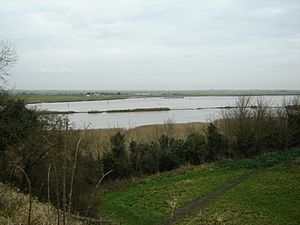Breydon Water facts for kids
| Site of Special Scientific Interest | |

Breydon's western end at the River Yare confluence as viewed from Burgh Castle
|
|
| Area of Search | Norfolk |
|---|---|
| Interest | Biological |
| Area | 514.4 hectares (1,271 acres) |
| Notification | 1987 |
| Location map | Magic Map |
|
Designations
|
|
| Official name: Breydon Water | |
| Designated: | 29 March 1996 |
|---|---|
| Reference #: | 821 |
Breydon Water is a very special natural area in Great Yarmouth, Norfolk. It covers about 514 hectares (which is over 1,200 acres). This area is important for nature, so it's called a Site of Special Scientific Interest. It's also a Local Nature Reserve, a Ramsar site (meaning it's a wetland of international importance), and a Special Protection Area for birds.
The Royal Society for the Protection of Birds (RSPB) helps look after Breydon Water. It's part of a bigger nature reserve called Berney Marshes and Breydon Water.
Breydon Water is a huge, calm estuary. An estuary is where a river meets the sea, and the water is often a mix of fresh and salt water. It's like a big entrance to The Broads river system. This area is on the eastern side of Halvergate Marshes. It's the UK's biggest protected wetland. A wetland is land that is covered by water, like marshes or swamps.
This amazing water body is about 5 kilometers (3 miles) long. In some places, it's more than 1.5 kilometers (1 mile) wide.
At its southern end, Breydon Water is overlooked by the old Roman fort at Burgh Castle. Long ago, Breydon Water was a much larger estuary that opened directly to the sea. At its western end, the water starts where the River Yare and River Waveney meet. Smaller streams also flow into it from the surrounding marshland. Boats can travel safely here by following red and green marker posts. Unlike most waterways in the Norfolk Broads, there is no speed limit on Breydon Water.
At the eastern end of Breydon Water, the river becomes a narrow channel again. It flows under Breydon Bridge and then joins the River Bure. After that, it goes under Haven Bridge. From there, it's about 4.4 kilometers (2.7 miles) through the harbour out to the North Sea.
Contents
What Makes Breydon Water Special?
A Haven for Wildlife
When the tide is low, huge areas of mudflats and salty marshes appear. These areas are full of birds. Since the mid-1980s, Breydon Water has been a nature reserve looked after by the RSPB. For hundreds of years, people used to hunt birds here. Hunting still happens, but much less now.
Amazing Birds to Spot
In winter, many wading birds and wildfowl come to Breydon Water to spend the colder months. You might see:
- About 12,000 golden plovers
- Around 12,000 wigeons
- About 32,000 lapwings
- Tens of thousands of Bewick's swans
Other birds that have been seen here include dunlins, sanderlings, and Eurasian whimbrels. Sometimes, even rare birds like pied avocets or a glossy ibis visit. A few (escaped) flamingos have also been spotted!
Bird Watching and Breeding Areas
There's a special place to watch birds at the eastern end of Breydon Water. It's on the north shore and looks out towards a platform where birds like common terns like to nest. Other birds that breed here include common shelducks, northern shovelers, Eurasian oystercatchers, and yellow wagtails.
Famous Connections
The naturalist Arthur Henry Patterson (1857–1935) wrote a lot about the wildlife of Breydon Water. He also wrote about the lives of the boatmen, hunters, and fishermen who made a living from the estuary. He used the pen name 'John Knowlittle'.
Parts of the Wherryman's Way and Weavers' Way walking paths follow the northern side of the estuary. These paths go from Yarmouth to Berney Arms, which is about 5 miles (8 kilometers). Breydon Water is also a setting in the popular Swallows and Amazons book, Coot Club.

